ITC571 - Emerging Technologies: Blockchain in Healthcare Project
VerifiedAdded on 2022/10/04
|14
|2584
|447
Project
AI Summary
This project proposal investigates the application of blockchain technology within the healthcare industry, addressing critical challenges such as data accuracy, drug traceability, and the secure sharing of patient information. The research aims to explore how blockchain can mitigate the risks of data fraud in clinical tests, optimize drug supply chains, and enhance patient data management. The proposal outlines the research objectives, questions, and a detailed methodology, including data collection methods, ethical considerations, and a project plan with a timeline and risk analysis. The expected outcomes include insights into curbing counterfeit drugs, securing patient data, and improving scientific collaboration through blockchain-based clinical trial structures. The proposal emphasizes the potential of blockchain to transform healthcare by providing secure and efficient data sharing systems across healthcare facilities, ultimately improving the quality and integrity of patient care.

Running head: EMERGING TECHNOLOGIES AND INNOVATION 1
Emerging Technologies and Innovation: Blockchain in Healthcare
Student’s Name
Institutional Affiliation
Emerging Technologies and Innovation: Blockchain in Healthcare
Student’s Name
Institutional Affiliation
Paraphrase This Document
Need a fresh take? Get an instant paraphrase of this document with our AI Paraphraser
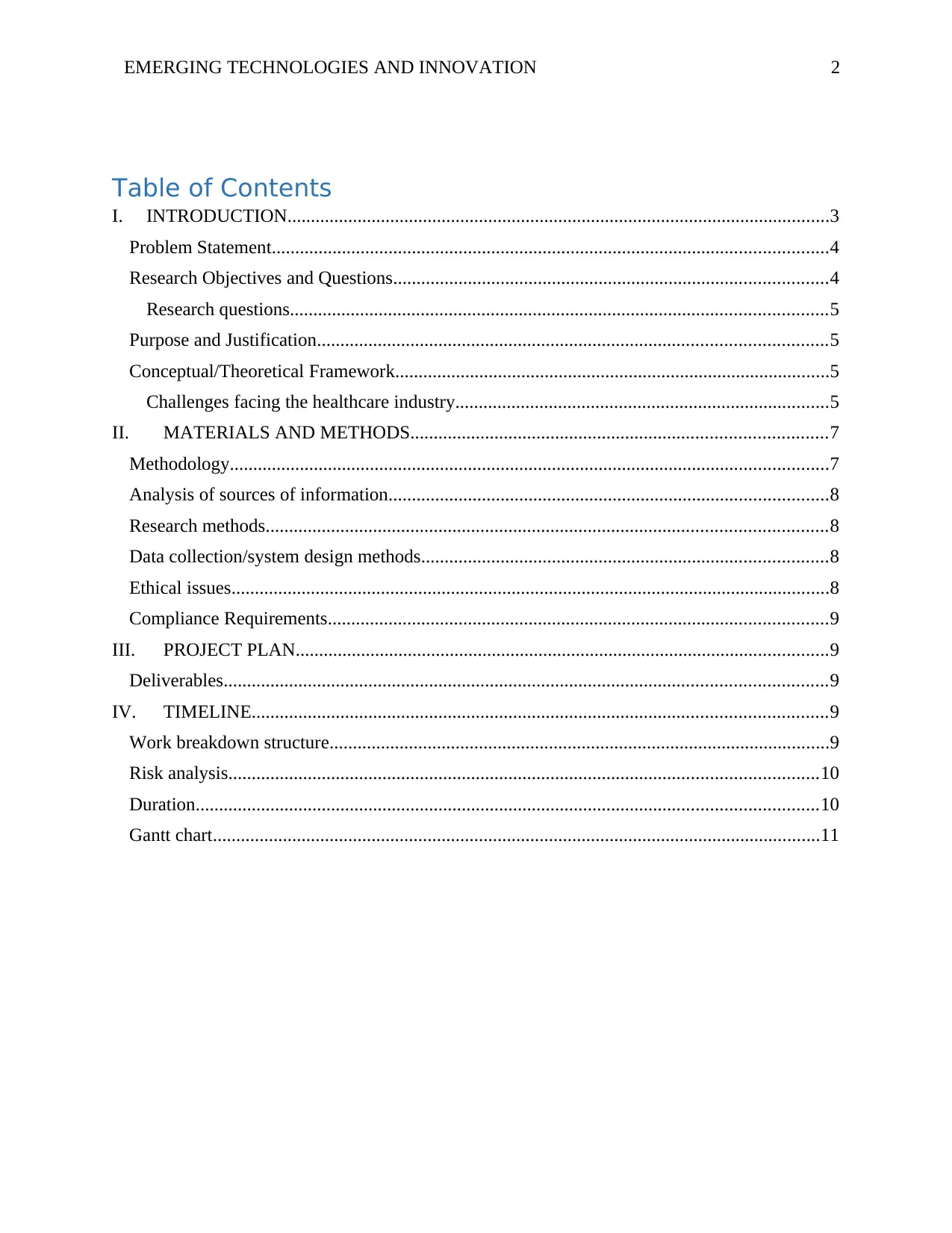
EMERGING TECHNOLOGIES AND INNOVATION 2
Table of Contents
I. INTRODUCTION....................................................................................................................3
Problem Statement.......................................................................................................................4
Research Objectives and Questions.............................................................................................4
Research questions...................................................................................................................5
Purpose and Justification.............................................................................................................5
Conceptual/Theoretical Framework.............................................................................................5
Challenges facing the healthcare industry................................................................................5
II. MATERIALS AND METHODS.........................................................................................7
Methodology................................................................................................................................7
Analysis of sources of information..............................................................................................8
Research methods........................................................................................................................8
Data collection/system design methods.......................................................................................8
Ethical issues................................................................................................................................8
Compliance Requirements...........................................................................................................9
III. PROJECT PLAN..................................................................................................................9
Deliverables.................................................................................................................................9
IV. TIMELINE...........................................................................................................................9
Work breakdown structure...........................................................................................................9
Risk analysis..............................................................................................................................10
Duration.....................................................................................................................................10
Gantt chart..................................................................................................................................11
Table of Contents
I. INTRODUCTION....................................................................................................................3
Problem Statement.......................................................................................................................4
Research Objectives and Questions.............................................................................................4
Research questions...................................................................................................................5
Purpose and Justification.............................................................................................................5
Conceptual/Theoretical Framework.............................................................................................5
Challenges facing the healthcare industry................................................................................5
II. MATERIALS AND METHODS.........................................................................................7
Methodology................................................................................................................................7
Analysis of sources of information..............................................................................................8
Research methods........................................................................................................................8
Data collection/system design methods.......................................................................................8
Ethical issues................................................................................................................................8
Compliance Requirements...........................................................................................................9
III. PROJECT PLAN..................................................................................................................9
Deliverables.................................................................................................................................9
IV. TIMELINE...........................................................................................................................9
Work breakdown structure...........................................................................................................9
Risk analysis..............................................................................................................................10
Duration.....................................................................................................................................10
Gantt chart..................................................................................................................................11
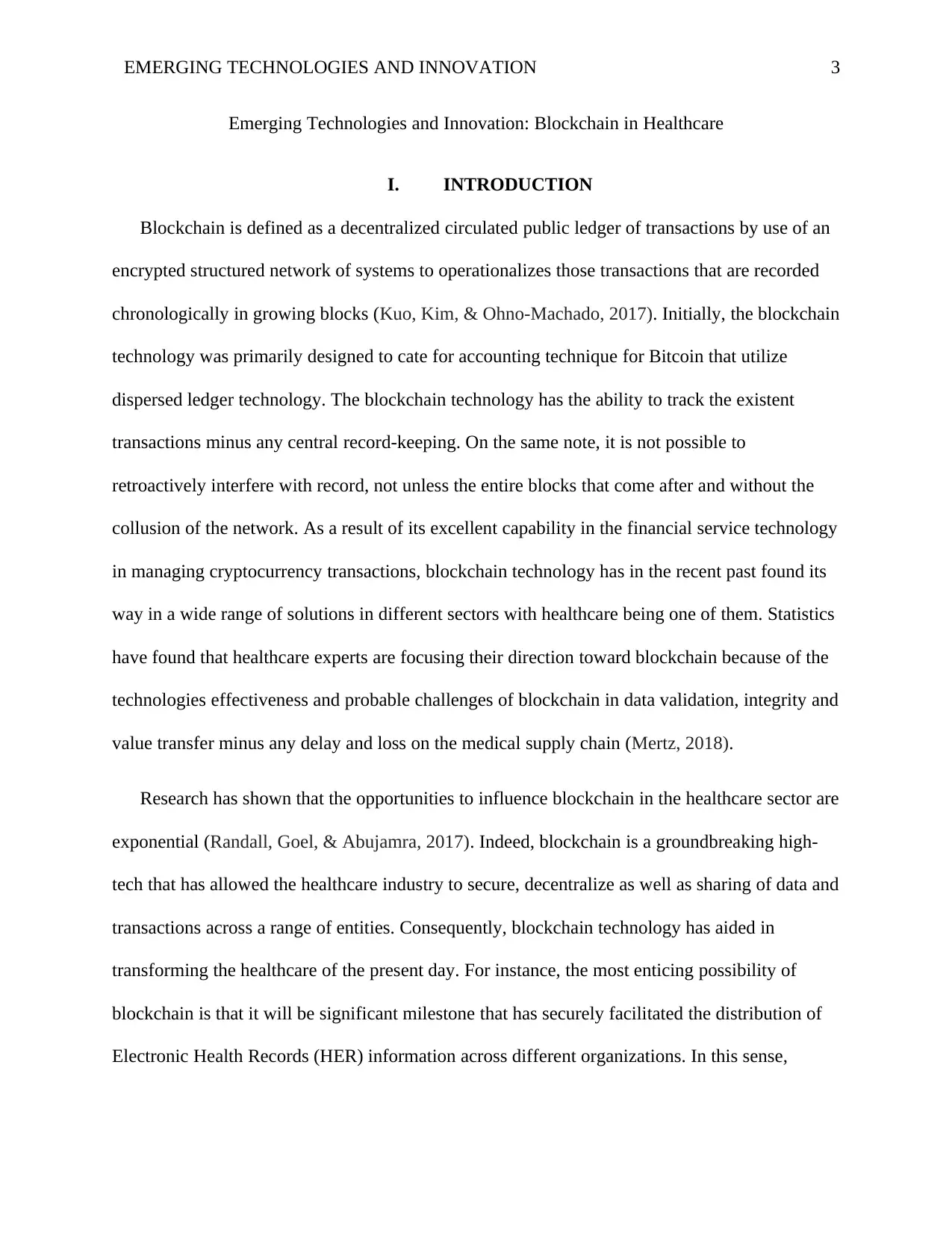
EMERGING TECHNOLOGIES AND INNOVATION 3
Emerging Technologies and Innovation: Blockchain in Healthcare
I. INTRODUCTION
Blockchain is defined as a decentralized circulated public ledger of transactions by use of an
encrypted structured network of systems to operationalizes those transactions that are recorded
chronologically in growing blocks (Kuo, Kim, & Ohno-Machado, 2017). Initially, the blockchain
technology was primarily designed to cate for accounting technique for Bitcoin that utilize
dispersed ledger technology. The blockchain technology has the ability to track the existent
transactions minus any central record-keeping. On the same note, it is not possible to
retroactively interfere with record, not unless the entire blocks that come after and without the
collusion of the network. As a result of its excellent capability in the financial service technology
in managing cryptocurrency transactions, blockchain technology has in the recent past found its
way in a wide range of solutions in different sectors with healthcare being one of them. Statistics
have found that healthcare experts are focusing their direction toward blockchain because of the
technologies effectiveness and probable challenges of blockchain in data validation, integrity and
value transfer minus any delay and loss on the medical supply chain (Mertz, 2018).
Research has shown that the opportunities to influence blockchain in the healthcare sector are
exponential (Randall, Goel, & Abujamra, 2017). Indeed, blockchain is a groundbreaking high-
tech that has allowed the healthcare industry to secure, decentralize as well as sharing of data and
transactions across a range of entities. Consequently, blockchain technology has aided in
transforming the healthcare of the present day. For instance, the most enticing possibility of
blockchain is that it will be significant milestone that has securely facilitated the distribution of
Electronic Health Records (HER) information across different organizations. In this sense,
Emerging Technologies and Innovation: Blockchain in Healthcare
I. INTRODUCTION
Blockchain is defined as a decentralized circulated public ledger of transactions by use of an
encrypted structured network of systems to operationalizes those transactions that are recorded
chronologically in growing blocks (Kuo, Kim, & Ohno-Machado, 2017). Initially, the blockchain
technology was primarily designed to cate for accounting technique for Bitcoin that utilize
dispersed ledger technology. The blockchain technology has the ability to track the existent
transactions minus any central record-keeping. On the same note, it is not possible to
retroactively interfere with record, not unless the entire blocks that come after and without the
collusion of the network. As a result of its excellent capability in the financial service technology
in managing cryptocurrency transactions, blockchain technology has in the recent past found its
way in a wide range of solutions in different sectors with healthcare being one of them. Statistics
have found that healthcare experts are focusing their direction toward blockchain because of the
technologies effectiveness and probable challenges of blockchain in data validation, integrity and
value transfer minus any delay and loss on the medical supply chain (Mertz, 2018).
Research has shown that the opportunities to influence blockchain in the healthcare sector are
exponential (Randall, Goel, & Abujamra, 2017). Indeed, blockchain is a groundbreaking high-
tech that has allowed the healthcare industry to secure, decentralize as well as sharing of data and
transactions across a range of entities. Consequently, blockchain technology has aided in
transforming the healthcare of the present day. For instance, the most enticing possibility of
blockchain is that it will be significant milestone that has securely facilitated the distribution of
Electronic Health Records (HER) information across different organizations. In this sense,
⊘ This is a preview!⊘
Do you want full access?
Subscribe today to unlock all pages.

Trusted by 1+ million students worldwide
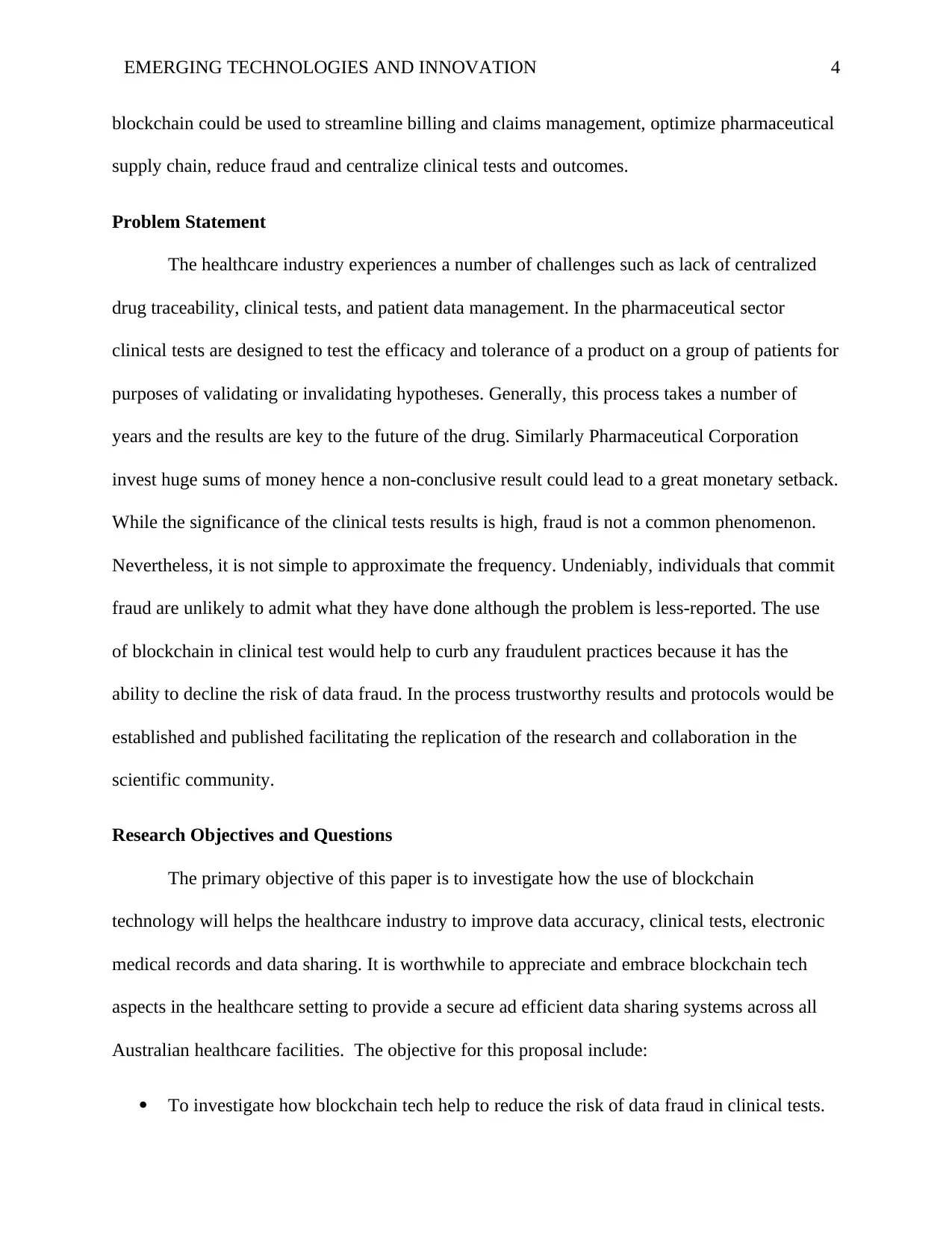
EMERGING TECHNOLOGIES AND INNOVATION 4
blockchain could be used to streamline billing and claims management, optimize pharmaceutical
supply chain, reduce fraud and centralize clinical tests and outcomes.
Problem Statement
The healthcare industry experiences a number of challenges such as lack of centralized
drug traceability, clinical tests, and patient data management. In the pharmaceutical sector
clinical tests are designed to test the efficacy and tolerance of a product on a group of patients for
purposes of validating or invalidating hypotheses. Generally, this process takes a number of
years and the results are key to the future of the drug. Similarly Pharmaceutical Corporation
invest huge sums of money hence a non-conclusive result could lead to a great monetary setback.
While the significance of the clinical tests results is high, fraud is not a common phenomenon.
Nevertheless, it is not simple to approximate the frequency. Undeniably, individuals that commit
fraud are unlikely to admit what they have done although the problem is less-reported. The use
of blockchain in clinical test would help to curb any fraudulent practices because it has the
ability to decline the risk of data fraud. In the process trustworthy results and protocols would be
established and published facilitating the replication of the research and collaboration in the
scientific community.
Research Objectives and Questions
The primary objective of this paper is to investigate how the use of blockchain
technology will helps the healthcare industry to improve data accuracy, clinical tests, electronic
medical records and data sharing. It is worthwhile to appreciate and embrace blockchain tech
aspects in the healthcare setting to provide a secure ad efficient data sharing systems across all
Australian healthcare facilities. The objective for this proposal include:
To investigate how blockchain tech help to reduce the risk of data fraud in clinical tests.
blockchain could be used to streamline billing and claims management, optimize pharmaceutical
supply chain, reduce fraud and centralize clinical tests and outcomes.
Problem Statement
The healthcare industry experiences a number of challenges such as lack of centralized
drug traceability, clinical tests, and patient data management. In the pharmaceutical sector
clinical tests are designed to test the efficacy and tolerance of a product on a group of patients for
purposes of validating or invalidating hypotheses. Generally, this process takes a number of
years and the results are key to the future of the drug. Similarly Pharmaceutical Corporation
invest huge sums of money hence a non-conclusive result could lead to a great monetary setback.
While the significance of the clinical tests results is high, fraud is not a common phenomenon.
Nevertheless, it is not simple to approximate the frequency. Undeniably, individuals that commit
fraud are unlikely to admit what they have done although the problem is less-reported. The use
of blockchain in clinical test would help to curb any fraudulent practices because it has the
ability to decline the risk of data fraud. In the process trustworthy results and protocols would be
established and published facilitating the replication of the research and collaboration in the
scientific community.
Research Objectives and Questions
The primary objective of this paper is to investigate how the use of blockchain
technology will helps the healthcare industry to improve data accuracy, clinical tests, electronic
medical records and data sharing. It is worthwhile to appreciate and embrace blockchain tech
aspects in the healthcare setting to provide a secure ad efficient data sharing systems across all
Australian healthcare facilities. The objective for this proposal include:
To investigate how blockchain tech help to reduce the risk of data fraud in clinical tests.
Paraphrase This Document
Need a fresh take? Get an instant paraphrase of this document with our AI Paraphraser
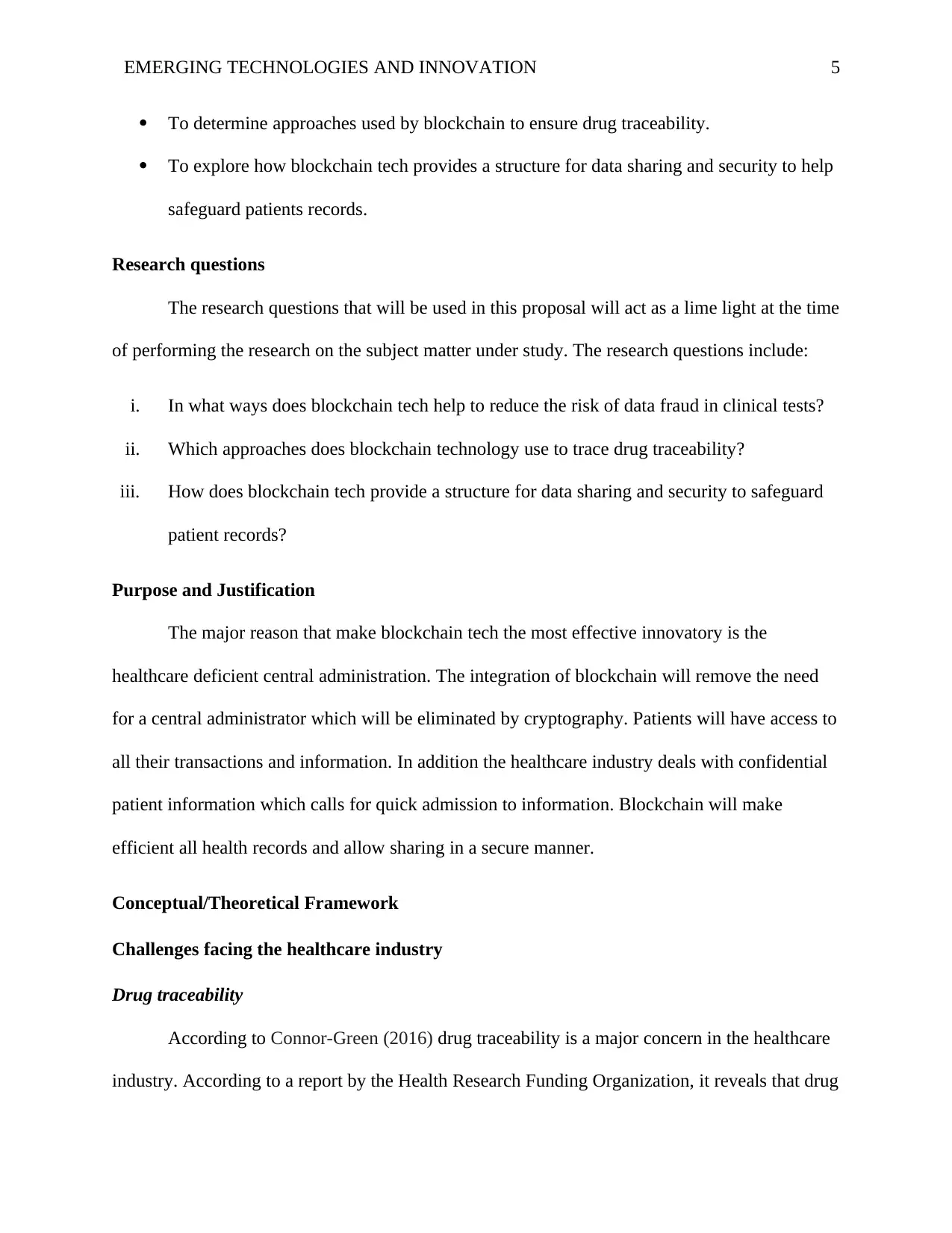
EMERGING TECHNOLOGIES AND INNOVATION 5
To determine approaches used by blockchain to ensure drug traceability.
To explore how blockchain tech provides a structure for data sharing and security to help
safeguard patients records.
Research questions
The research questions that will be used in this proposal will act as a lime light at the time
of performing the research on the subject matter under study. The research questions include:
i. In what ways does blockchain tech help to reduce the risk of data fraud in clinical tests?
ii. Which approaches does blockchain technology use to trace drug traceability?
iii. How does blockchain tech provide a structure for data sharing and security to safeguard
patient records?
Purpose and Justification
The major reason that make blockchain tech the most effective innovatory is the
healthcare deficient central administration. The integration of blockchain will remove the need
for a central administrator which will be eliminated by cryptography. Patients will have access to
all their transactions and information. In addition the healthcare industry deals with confidential
patient information which calls for quick admission to information. Blockchain will make
efficient all health records and allow sharing in a secure manner.
Conceptual/Theoretical Framework
Challenges facing the healthcare industry
Drug traceability
According to Connor-Green (2016) drug traceability is a major concern in the healthcare
industry. According to a report by the Health Research Funding Organization, it reveals that drug
To determine approaches used by blockchain to ensure drug traceability.
To explore how blockchain tech provides a structure for data sharing and security to help
safeguard patients records.
Research questions
The research questions that will be used in this proposal will act as a lime light at the time
of performing the research on the subject matter under study. The research questions include:
i. In what ways does blockchain tech help to reduce the risk of data fraud in clinical tests?
ii. Which approaches does blockchain technology use to trace drug traceability?
iii. How does blockchain tech provide a structure for data sharing and security to safeguard
patient records?
Purpose and Justification
The major reason that make blockchain tech the most effective innovatory is the
healthcare deficient central administration. The integration of blockchain will remove the need
for a central administrator which will be eliminated by cryptography. Patients will have access to
all their transactions and information. In addition the healthcare industry deals with confidential
patient information which calls for quick admission to information. Blockchain will make
efficient all health records and allow sharing in a secure manner.
Conceptual/Theoretical Framework
Challenges facing the healthcare industry
Drug traceability
According to Connor-Green (2016) drug traceability is a major concern in the healthcare
industry. According to a report by the Health Research Funding Organization, it reveals that drug
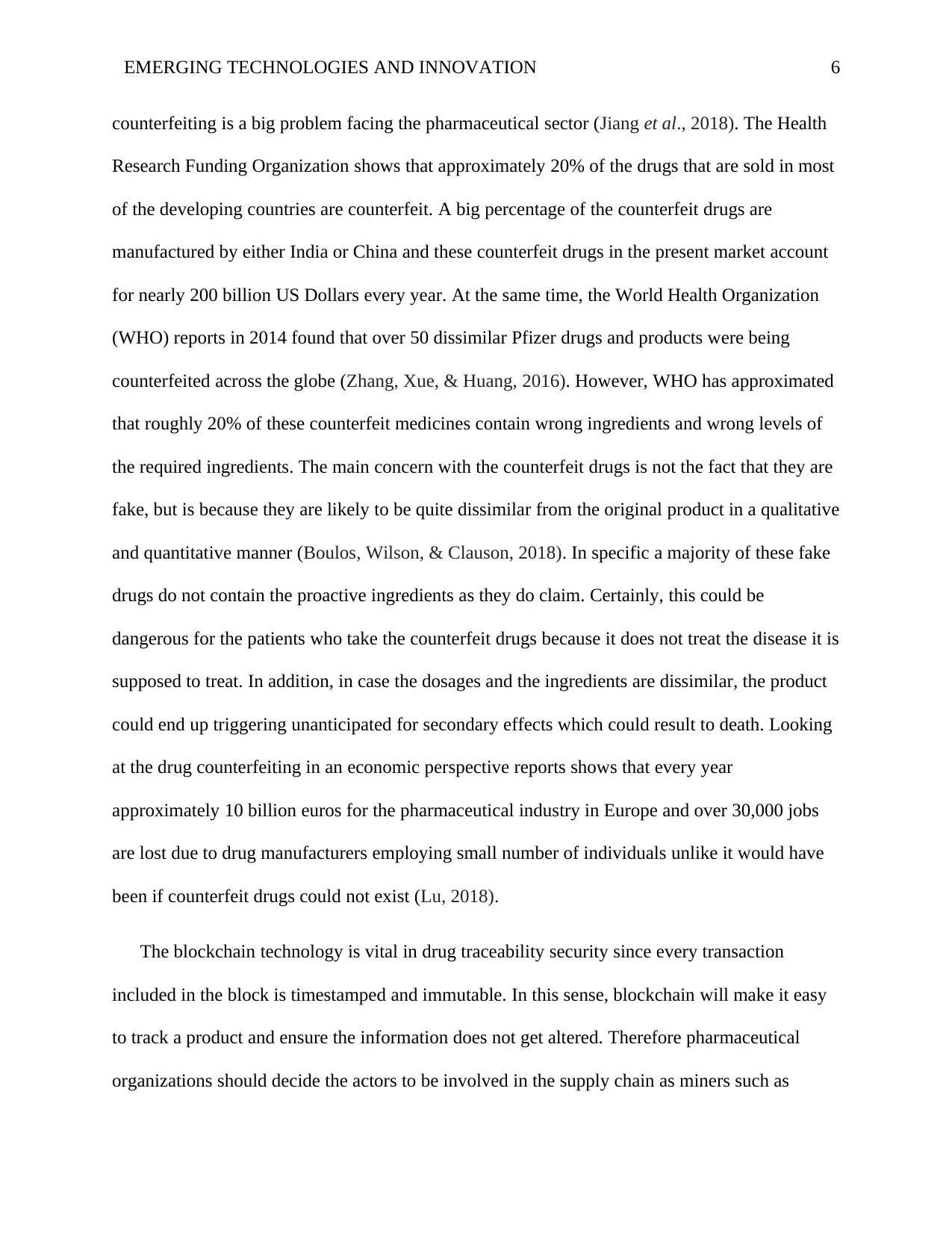
EMERGING TECHNOLOGIES AND INNOVATION 6
counterfeiting is a big problem facing the pharmaceutical sector (Jiang et al., 2018). The Health
Research Funding Organization shows that approximately 20% of the drugs that are sold in most
of the developing countries are counterfeit. A big percentage of the counterfeit drugs are
manufactured by either India or China and these counterfeit drugs in the present market account
for nearly 200 billion US Dollars every year. At the same time, the World Health Organization
(WHO) reports in 2014 found that over 50 dissimilar Pfizer drugs and products were being
counterfeited across the globe (Zhang, Xue, & Huang, 2016). However, WHO has approximated
that roughly 20% of these counterfeit medicines contain wrong ingredients and wrong levels of
the required ingredients. The main concern with the counterfeit drugs is not the fact that they are
fake, but is because they are likely to be quite dissimilar from the original product in a qualitative
and quantitative manner (Boulos, Wilson, & Clauson, 2018). In specific a majority of these fake
drugs do not contain the proactive ingredients as they do claim. Certainly, this could be
dangerous for the patients who take the counterfeit drugs because it does not treat the disease it is
supposed to treat. In addition, in case the dosages and the ingredients are dissimilar, the product
could end up triggering unanticipated for secondary effects which could result to death. Looking
at the drug counterfeiting in an economic perspective reports shows that every year
approximately 10 billion euros for the pharmaceutical industry in Europe and over 30,000 jobs
are lost due to drug manufacturers employing small number of individuals unlike it would have
been if counterfeit drugs could not exist (Lu, 2018).
The blockchain technology is vital in drug traceability security since every transaction
included in the block is timestamped and immutable. In this sense, blockchain will make it easy
to track a product and ensure the information does not get altered. Therefore pharmaceutical
organizations should decide the actors to be involved in the supply chain as miners such as
counterfeiting is a big problem facing the pharmaceutical sector (Jiang et al., 2018). The Health
Research Funding Organization shows that approximately 20% of the drugs that are sold in most
of the developing countries are counterfeit. A big percentage of the counterfeit drugs are
manufactured by either India or China and these counterfeit drugs in the present market account
for nearly 200 billion US Dollars every year. At the same time, the World Health Organization
(WHO) reports in 2014 found that over 50 dissimilar Pfizer drugs and products were being
counterfeited across the globe (Zhang, Xue, & Huang, 2016). However, WHO has approximated
that roughly 20% of these counterfeit medicines contain wrong ingredients and wrong levels of
the required ingredients. The main concern with the counterfeit drugs is not the fact that they are
fake, but is because they are likely to be quite dissimilar from the original product in a qualitative
and quantitative manner (Boulos, Wilson, & Clauson, 2018). In specific a majority of these fake
drugs do not contain the proactive ingredients as they do claim. Certainly, this could be
dangerous for the patients who take the counterfeit drugs because it does not treat the disease it is
supposed to treat. In addition, in case the dosages and the ingredients are dissimilar, the product
could end up triggering unanticipated for secondary effects which could result to death. Looking
at the drug counterfeiting in an economic perspective reports shows that every year
approximately 10 billion euros for the pharmaceutical industry in Europe and over 30,000 jobs
are lost due to drug manufacturers employing small number of individuals unlike it would have
been if counterfeit drugs could not exist (Lu, 2018).
The blockchain technology is vital in drug traceability security since every transaction
included in the block is timestamped and immutable. In this sense, blockchain will make it easy
to track a product and ensure the information does not get altered. Therefore pharmaceutical
organizations should decide the actors to be involved in the supply chain as miners such as
⊘ This is a preview!⊘
Do you want full access?
Subscribe today to unlock all pages.

Trusted by 1+ million students worldwide
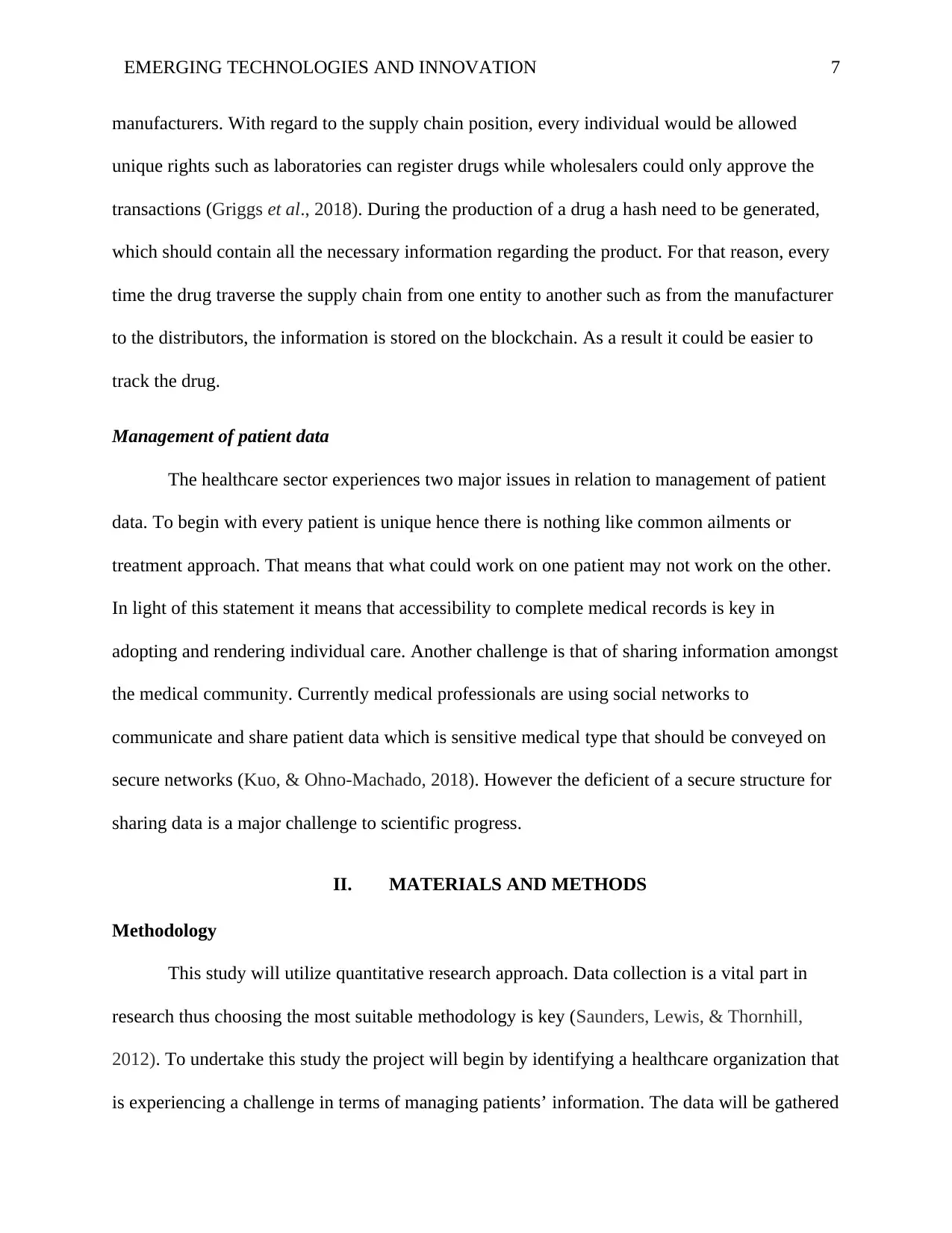
EMERGING TECHNOLOGIES AND INNOVATION 7
manufacturers. With regard to the supply chain position, every individual would be allowed
unique rights such as laboratories can register drugs while wholesalers could only approve the
transactions (Griggs et al., 2018). During the production of a drug a hash need to be generated,
which should contain all the necessary information regarding the product. For that reason, every
time the drug traverse the supply chain from one entity to another such as from the manufacturer
to the distributors, the information is stored on the blockchain. As a result it could be easier to
track the drug.
Management of patient data
The healthcare sector experiences two major issues in relation to management of patient
data. To begin with every patient is unique hence there is nothing like common ailments or
treatment approach. That means that what could work on one patient may not work on the other.
In light of this statement it means that accessibility to complete medical records is key in
adopting and rendering individual care. Another challenge is that of sharing information amongst
the medical community. Currently medical professionals are using social networks to
communicate and share patient data which is sensitive medical type that should be conveyed on
secure networks (Kuo, & Ohno-Machado, 2018). However the deficient of a secure structure for
sharing data is a major challenge to scientific progress.
II. MATERIALS AND METHODS
Methodology
This study will utilize quantitative research approach. Data collection is a vital part in
research thus choosing the most suitable methodology is key (Saunders, Lewis, & Thornhill,
2012). To undertake this study the project will begin by identifying a healthcare organization that
is experiencing a challenge in terms of managing patients’ information. The data will be gathered
manufacturers. With regard to the supply chain position, every individual would be allowed
unique rights such as laboratories can register drugs while wholesalers could only approve the
transactions (Griggs et al., 2018). During the production of a drug a hash need to be generated,
which should contain all the necessary information regarding the product. For that reason, every
time the drug traverse the supply chain from one entity to another such as from the manufacturer
to the distributors, the information is stored on the blockchain. As a result it could be easier to
track the drug.
Management of patient data
The healthcare sector experiences two major issues in relation to management of patient
data. To begin with every patient is unique hence there is nothing like common ailments or
treatment approach. That means that what could work on one patient may not work on the other.
In light of this statement it means that accessibility to complete medical records is key in
adopting and rendering individual care. Another challenge is that of sharing information amongst
the medical community. Currently medical professionals are using social networks to
communicate and share patient data which is sensitive medical type that should be conveyed on
secure networks (Kuo, & Ohno-Machado, 2018). However the deficient of a secure structure for
sharing data is a major challenge to scientific progress.
II. MATERIALS AND METHODS
Methodology
This study will utilize quantitative research approach. Data collection is a vital part in
research thus choosing the most suitable methodology is key (Saunders, Lewis, & Thornhill,
2012). To undertake this study the project will begin by identifying a healthcare organization that
is experiencing a challenge in terms of managing patients’ information. The data will be gathered
Paraphrase This Document
Need a fresh take? Get an instant paraphrase of this document with our AI Paraphraser
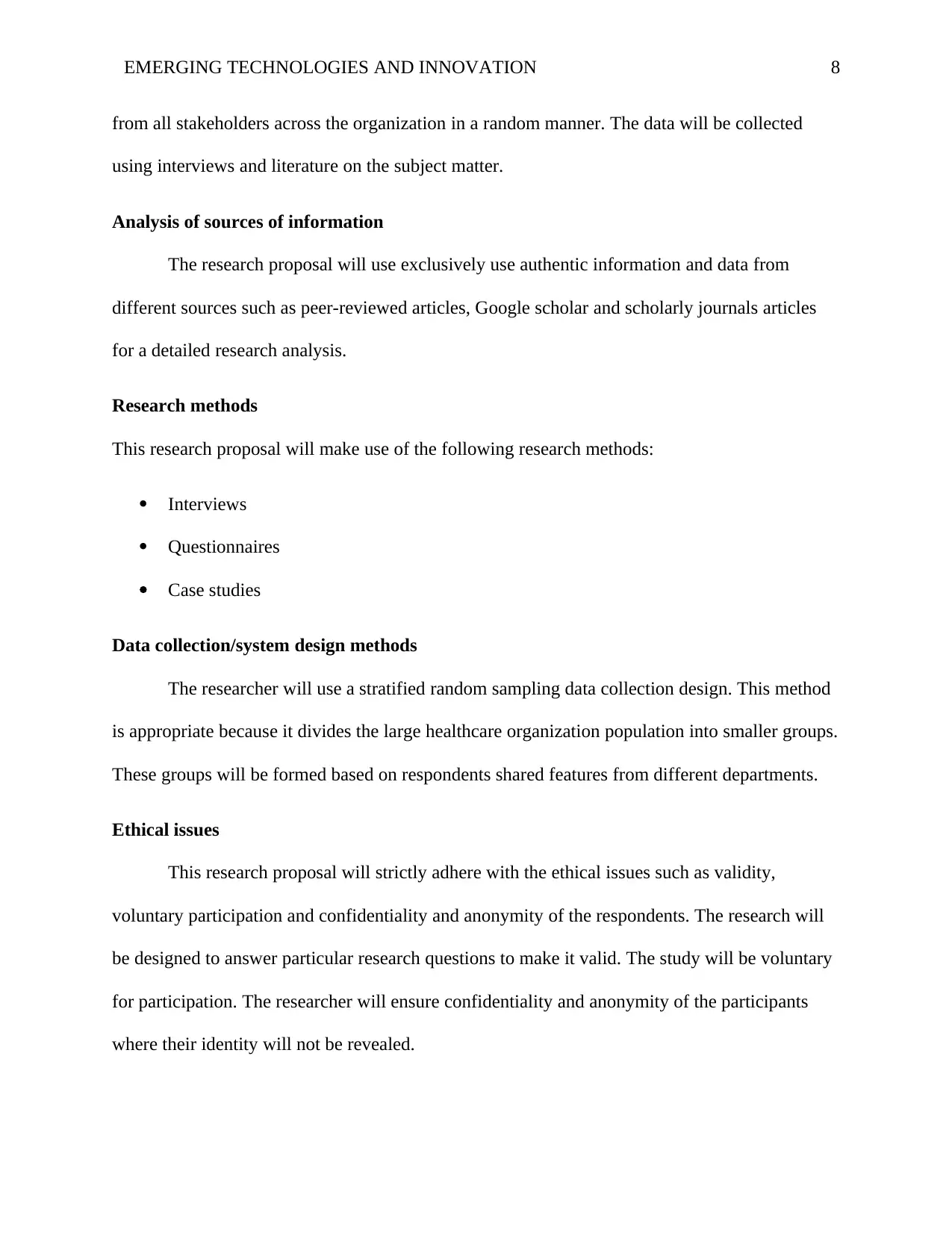
EMERGING TECHNOLOGIES AND INNOVATION 8
from all stakeholders across the organization in a random manner. The data will be collected
using interviews and literature on the subject matter.
Analysis of sources of information
The research proposal will use exclusively use authentic information and data from
different sources such as peer-reviewed articles, Google scholar and scholarly journals articles
for a detailed research analysis.
Research methods
This research proposal will make use of the following research methods:
Interviews
Questionnaires
Case studies
Data collection/system design methods
The researcher will use a stratified random sampling data collection design. This method
is appropriate because it divides the large healthcare organization population into smaller groups.
These groups will be formed based on respondents shared features from different departments.
Ethical issues
This research proposal will strictly adhere with the ethical issues such as validity,
voluntary participation and confidentiality and anonymity of the respondents. The research will
be designed to answer particular research questions to make it valid. The study will be voluntary
for participation. The researcher will ensure confidentiality and anonymity of the participants
where their identity will not be revealed.
from all stakeholders across the organization in a random manner. The data will be collected
using interviews and literature on the subject matter.
Analysis of sources of information
The research proposal will use exclusively use authentic information and data from
different sources such as peer-reviewed articles, Google scholar and scholarly journals articles
for a detailed research analysis.
Research methods
This research proposal will make use of the following research methods:
Interviews
Questionnaires
Case studies
Data collection/system design methods
The researcher will use a stratified random sampling data collection design. This method
is appropriate because it divides the large healthcare organization population into smaller groups.
These groups will be formed based on respondents shared features from different departments.
Ethical issues
This research proposal will strictly adhere with the ethical issues such as validity,
voluntary participation and confidentiality and anonymity of the respondents. The research will
be designed to answer particular research questions to make it valid. The study will be voluntary
for participation. The researcher will ensure confidentiality and anonymity of the participants
where their identity will not be revealed.
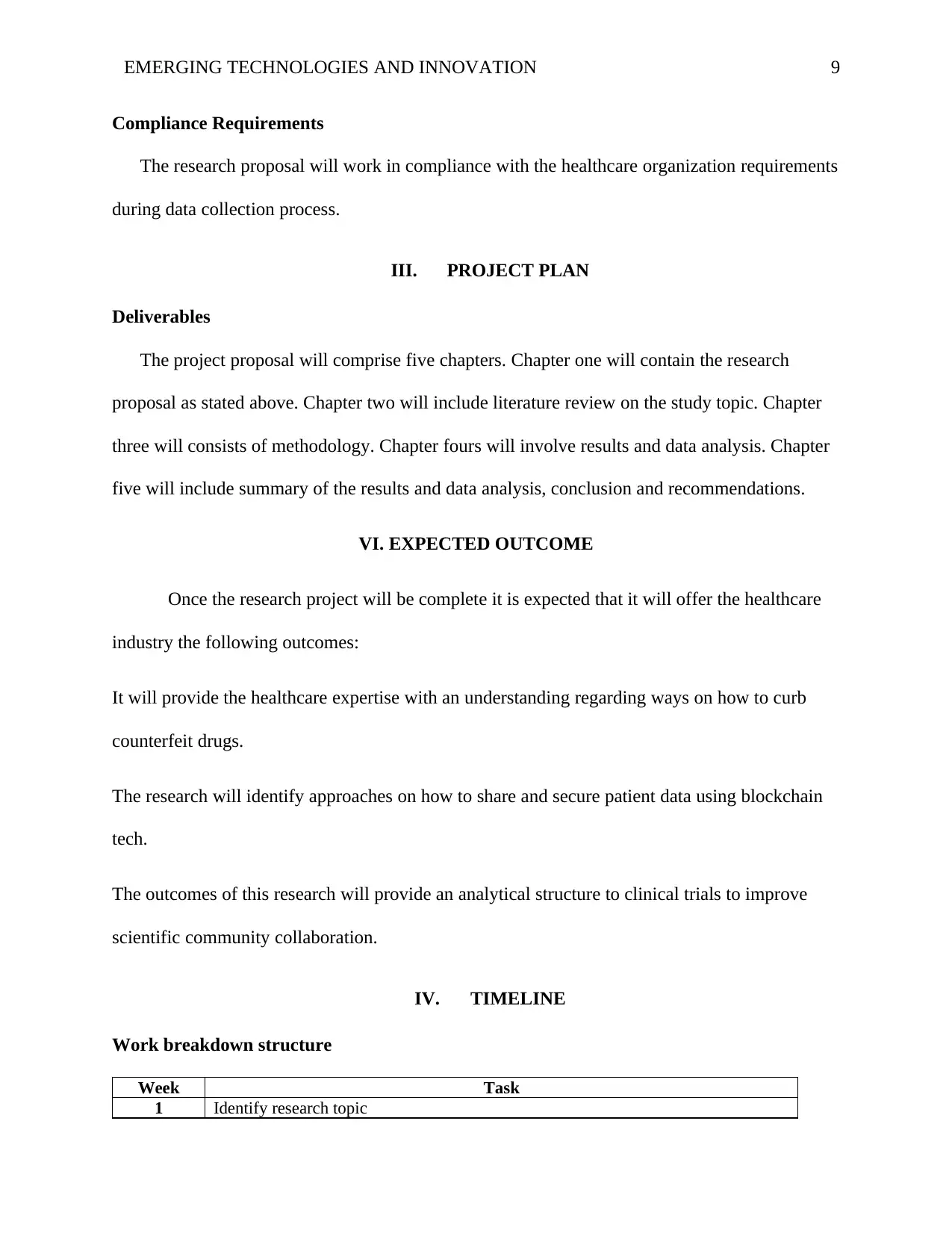
EMERGING TECHNOLOGIES AND INNOVATION 9
Compliance Requirements
The research proposal will work in compliance with the healthcare organization requirements
during data collection process.
III. PROJECT PLAN
Deliverables
The project proposal will comprise five chapters. Chapter one will contain the research
proposal as stated above. Chapter two will include literature review on the study topic. Chapter
three will consists of methodology. Chapter fours will involve results and data analysis. Chapter
five will include summary of the results and data analysis, conclusion and recommendations.
VI. EXPECTED OUTCOME
Once the research project will be complete it is expected that it will offer the healthcare
industry the following outcomes:
It will provide the healthcare expertise with an understanding regarding ways on how to curb
counterfeit drugs.
The research will identify approaches on how to share and secure patient data using blockchain
tech.
The outcomes of this research will provide an analytical structure to clinical trials to improve
scientific community collaboration.
IV. TIMELINE
Work breakdown structure
Week Task
1 Identify research topic
Compliance Requirements
The research proposal will work in compliance with the healthcare organization requirements
during data collection process.
III. PROJECT PLAN
Deliverables
The project proposal will comprise five chapters. Chapter one will contain the research
proposal as stated above. Chapter two will include literature review on the study topic. Chapter
three will consists of methodology. Chapter fours will involve results and data analysis. Chapter
five will include summary of the results and data analysis, conclusion and recommendations.
VI. EXPECTED OUTCOME
Once the research project will be complete it is expected that it will offer the healthcare
industry the following outcomes:
It will provide the healthcare expertise with an understanding regarding ways on how to curb
counterfeit drugs.
The research will identify approaches on how to share and secure patient data using blockchain
tech.
The outcomes of this research will provide an analytical structure to clinical trials to improve
scientific community collaboration.
IV. TIMELINE
Work breakdown structure
Week Task
1 Identify research topic
⊘ This is a preview!⊘
Do you want full access?
Subscribe today to unlock all pages.

Trusted by 1+ million students worldwide
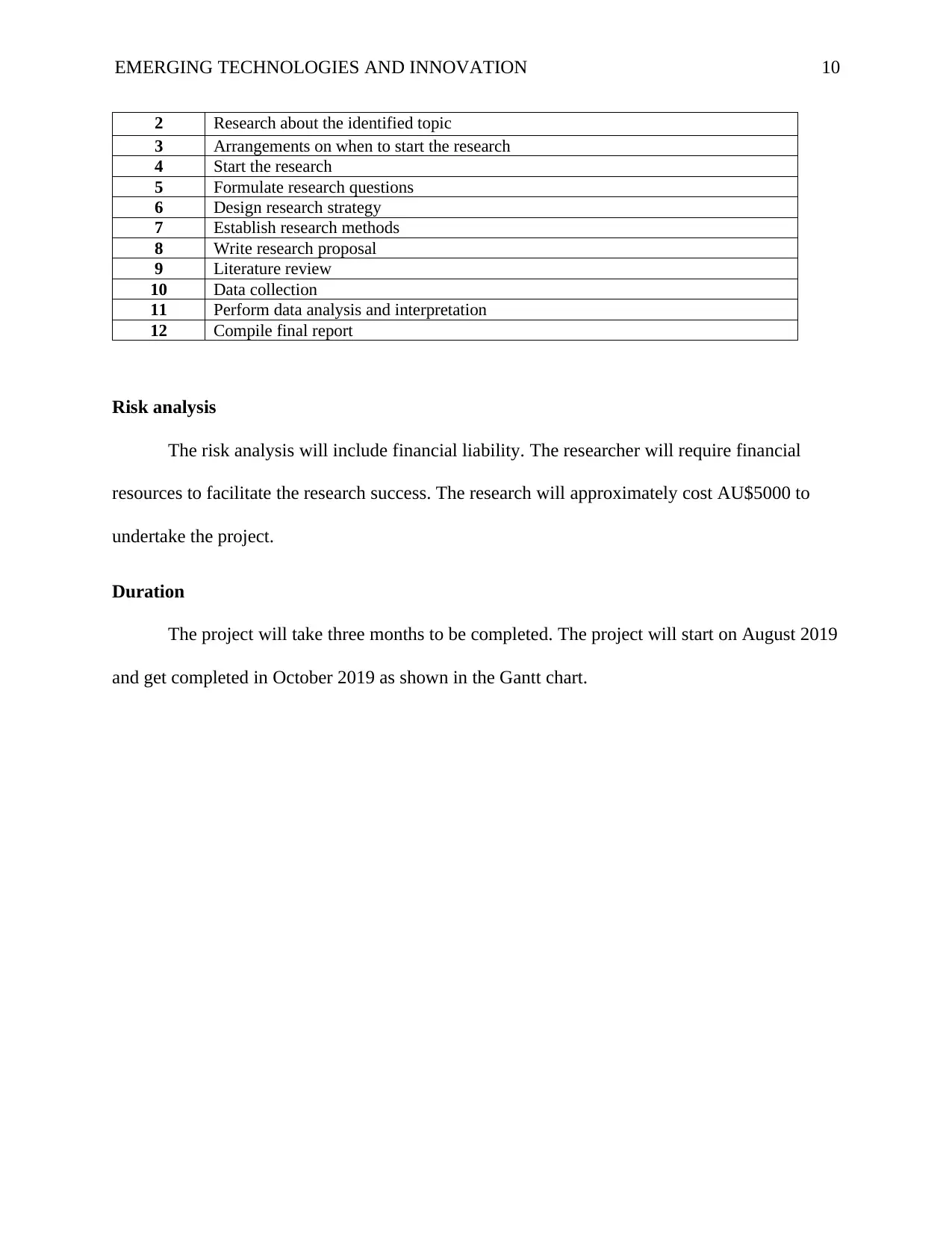
EMERGING TECHNOLOGIES AND INNOVATION 10
2 Research about the identified topic
3 Arrangements on when to start the research
4 Start the research
5 Formulate research questions
6 Design research strategy
7 Establish research methods
8 Write research proposal
9 Literature review
10 Data collection
11 Perform data analysis and interpretation
12 Compile final report
Risk analysis
The risk analysis will include financial liability. The researcher will require financial
resources to facilitate the research success. The research will approximately cost AU$5000 to
undertake the project.
Duration
The project will take three months to be completed. The project will start on August 2019
and get completed in October 2019 as shown in the Gantt chart.
2 Research about the identified topic
3 Arrangements on when to start the research
4 Start the research
5 Formulate research questions
6 Design research strategy
7 Establish research methods
8 Write research proposal
9 Literature review
10 Data collection
11 Perform data analysis and interpretation
12 Compile final report
Risk analysis
The risk analysis will include financial liability. The researcher will require financial
resources to facilitate the research success. The research will approximately cost AU$5000 to
undertake the project.
Duration
The project will take three months to be completed. The project will start on August 2019
and get completed in October 2019 as shown in the Gantt chart.
Paraphrase This Document
Need a fresh take? Get an instant paraphrase of this document with our AI Paraphraser
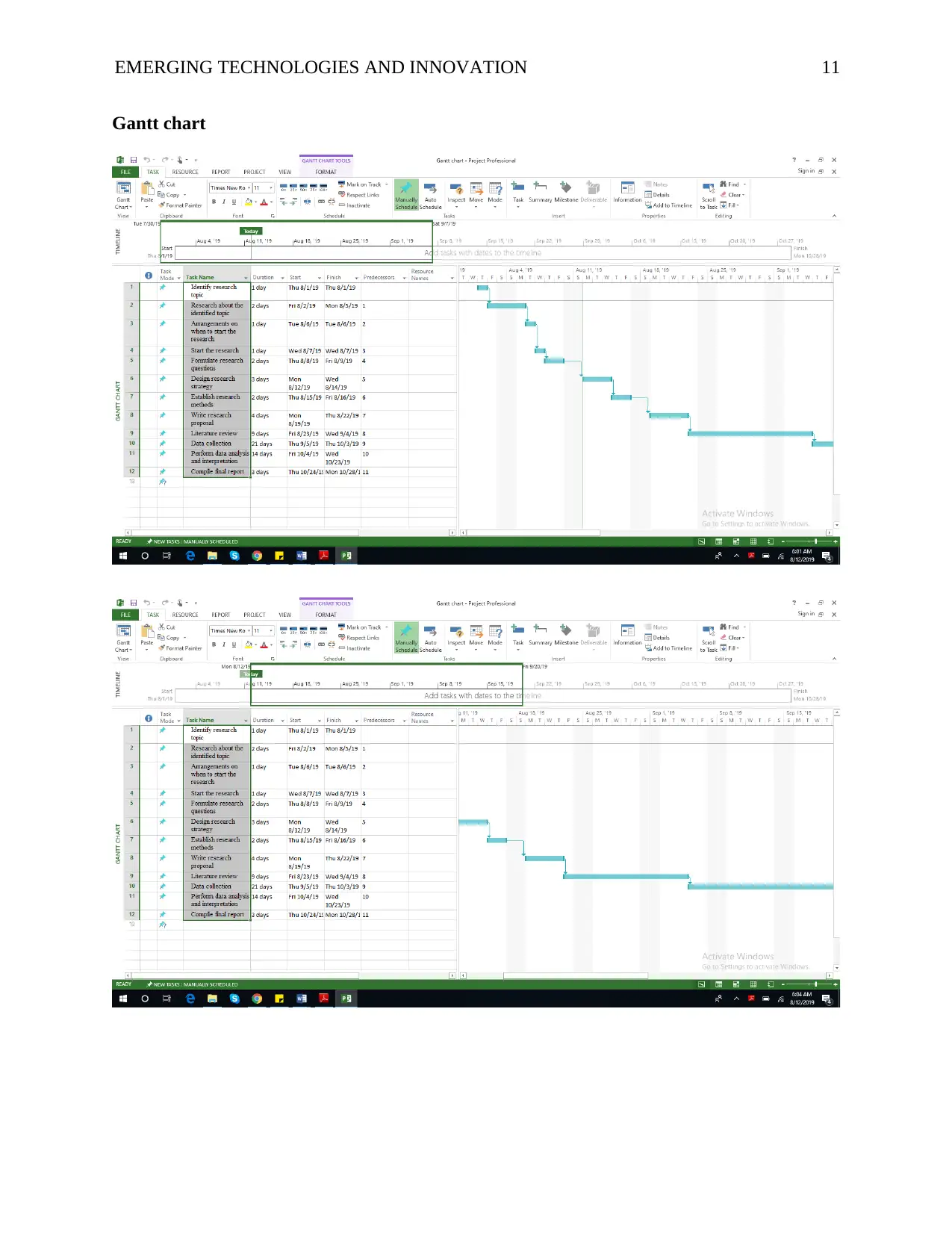
EMERGING TECHNOLOGIES AND INNOVATION 11
Gantt chart
Gantt chart
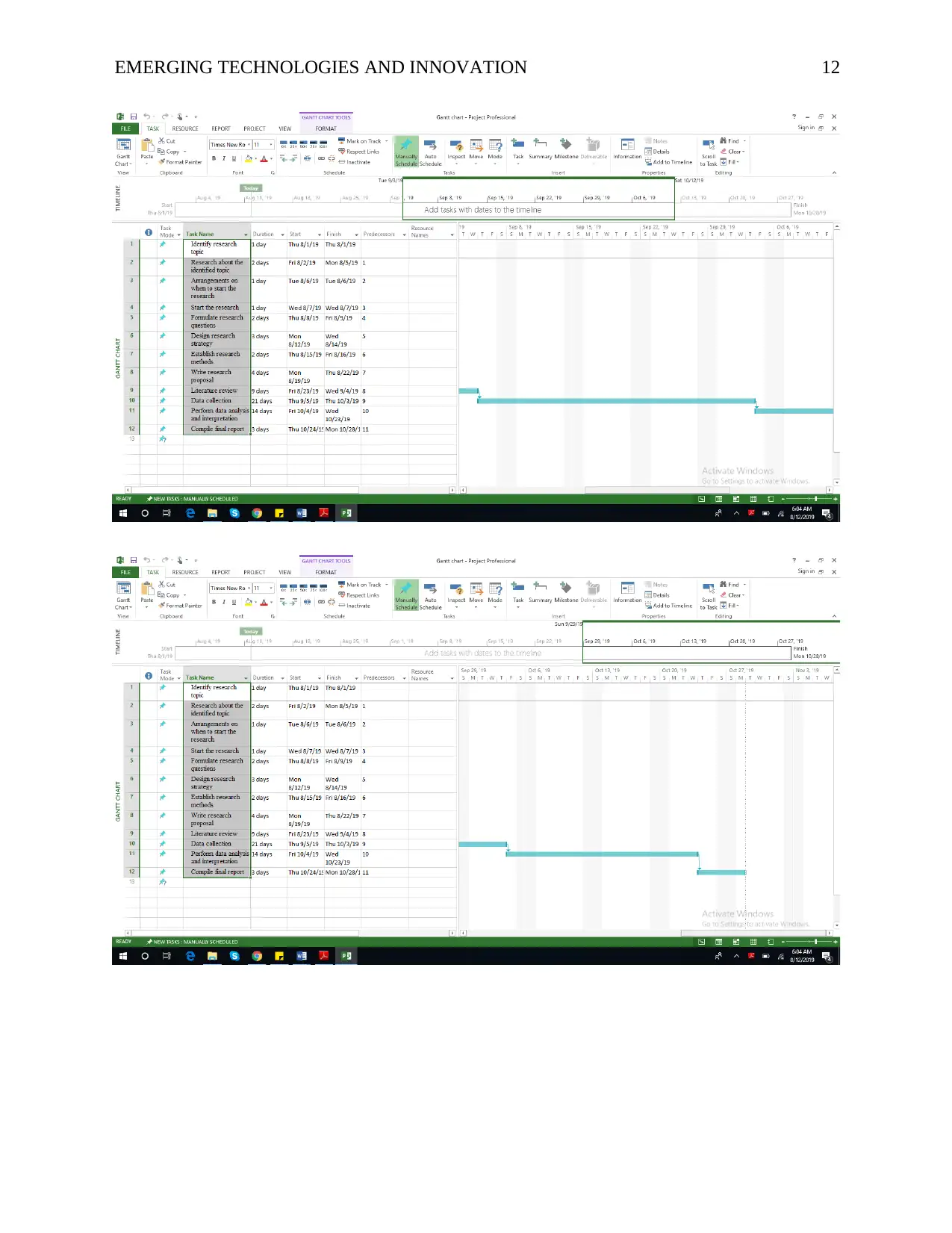
EMERGING TECHNOLOGIES AND INNOVATION 12
⊘ This is a preview!⊘
Do you want full access?
Subscribe today to unlock all pages.

Trusted by 1+ million students worldwide
1 out of 14
Related Documents
Your All-in-One AI-Powered Toolkit for Academic Success.
+13062052269
info@desklib.com
Available 24*7 on WhatsApp / Email
![[object Object]](/_next/static/media/star-bottom.7253800d.svg)
Unlock your academic potential
Copyright © 2020–2025 A2Z Services. All Rights Reserved. Developed and managed by ZUCOL.




